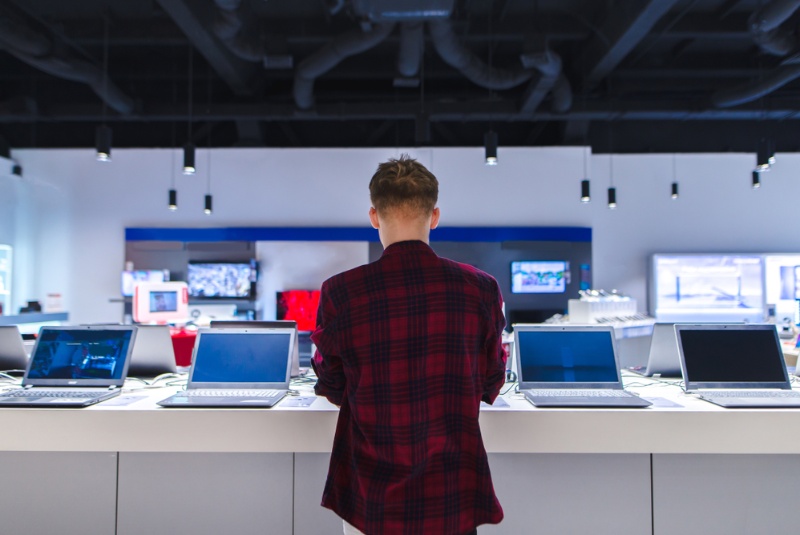In today’s fast-paced technological world, selecting the right laptop can seem overwhelming. From sleek ultrabooks to gaming laptops and powerful workstations, there’s an option for every type of user. But how do you find the ideal laptop to fit your needs?
1. Understand Your Requirements
Before diving into the specs, take a moment to assess what you need from a laptop. Are you a student who needs a lightweight device for taking notes, or are you a business professional requiring robust multitasking capabilities? Each user has unique requirements that should influence their choice of laptop.
- Students: Typically benefit from a portable laptop with long battery life, focusing on essential features like a decent keyboard, basic software compatibility, and budget-friendly options.
- Creative Professionals: Graphic designers, video editors, and digital artists need laptops with powerful CPUs, ample RAM, and often a dedicated graphics card to handle demanding applications.
- Gamers: Require high-performance laptops with fast processors, significant RAM, and dedicated GPUs to run games smoothly with high frame rates and quality graphics.
- Business Professionals: May look for durable, high-performance laptops with extensive connectivity options, solid security features, and efficient multitasking capabilities.
Understanding what you’ll primarily use the laptop for will guide your choices, ensuring you get the best features suited to your daily tasks.
2. Operating System Preferences
The operating system (OS) is crucial to your laptop experience, as it affects software compatibility, user interface, and overall functionality. The three primary operating systems—Windows, macOS, and Linux—offer distinct advantages.
- Windows: Known for compatibility with a wide range of software, Windows is versatile and user-friendly. It’s great for both general and professional use and is often the go-to for gaming and business laptops.
- macOS: macOS is exclusive to Apple devices and is favored for its security, seamless integration with other Apple products, and reliability. Many creative professionals prefer macOS for its compatibility with design and video editing software.
- Linux: Linux is open-source and highly customizable, making it popular among tech-savvy users and developers. It requires more technical knowledge but offers great flexibility and security.
Choose the OS that best aligns with your needs, and keep in mind that switching operating systems (such as moving from Windows to macOS) may have a learning curve.
3. Processor and RAM: The Heart and Brain of Your Laptop
Your laptop’s processor (CPU) and memory (RAM) have a substantial impact on its speed and performance. Processors are available in multiple configurations, each tailored to different performance levels.
- Basic Users: For casual browsing, email, and document handling, an Intel Core i3 or AMD Ryzen 3 processor paired with 4GB to 8GB of RAM should suffice.
- Intermediate Users: For moderate multitasking, photo editing, or coding, look for Intel Core i5 or AMD Ryzen 5 processors with at least 8GB of RAM. These configurations handle typical office and home applications smoothly.
- Power Users and Gamers: Opt for Intel Core i7/i9 or AMD Ryzen 7/9 processors with 16GB of RAM or more. These higher-end configurations provide the power needed for demanding tasks like gaming, video editing, and complex simulations.
RAM impacts the device’s multitasking capability, so if you often have multiple applications open, aim for 8GB as a minimum. For more intensive use, 16GB or even 32GB will deliver smoother performance.
4. Storage: Space to Hoard or Not
Storage options affect both speed and capacity. Solid-state drives (SSDs) are faster than traditional hard drives (HDDs) and contribute to better overall system performance.
- SSD: SSDs are faster, more durable, and quieter, making them the preferred choice for most users. They improve boot times, application loading, and file transfers.
- HDD: Hard disk drives offer higher storage capacities at lower costs but are slower than SSDs. HDDs are more prone to physical damage and slower read/write speeds.
- Hybrid: Some laptops offer a combination of SSD and HDD, providing a balance of speed (SSD) and storage space (HDD) for users who need both.
For everyday use, an SSD of at least 256GB is recommended. If you handle large files, such as videos or extensive data, consider a laptop with both SSD and HDD for an optimal balance of speed and storage capacity.
5. Display: A Window to the Digital World
The display is where all the visual action happens, so its quality impacts your viewing experience. Consider the resolution, size, and panel type when choosing a display.
- Resolution: A Full HD (1920x1080) resolution is standard for most users, offering crisp visuals and clear text. For graphic work or gaming, a higher resolution like 4K may be preferable.
- Size: Smaller laptops (13-14 inches) are more portable, while larger screens (15-17 inches) are ideal for users who need more screen real estate for work or media consumption.
- Panel Type: IPS panels offer better color accuracy and wider viewing angles, making them suitable for creative tasks. TN panels, though faster, have narrower viewing angles and color range, and OLED displays provide richer colors and contrast.

Your choice of display should cater to your daily tasks. Larger screens offer an enhanced experience for content creation and gaming, while smaller screens are more convenient for travel.
6. Battery Life: Keeping You Unplugged
Battery life is a critical factor for those who work on the go. The laptop’s usage and the screen size both affect battery life, so consider what level of mobility you need.
- For Office Use: If you plan to use your laptop mainly at a desk, battery life may not be as important. However, a laptop with a battery life of at least 5-6 hours provides flexibility.
- For On-the-Go Use: A laptop with 8-12 hours of battery life is ideal for those who frequently travel or work remotely. Consider models optimized for battery efficiency and lighter tasks.
- Performance Mode: Gaming or high-performance laptops drain the battery faster. Opt for laptops with “battery-saver” modes if you prioritize longevity over peak performance.
Battery life varies significantly across laptops, so aim for a balance between performance and power consumption to suit your lifestyle.
7. Additional Features: The Cherry on Top
While additional features may not be essential, they can greatly enhance your user experience and convenience. Consider these extras when making your choice:
- Touchscreen: Ideal for those who prefer interactive displays or frequently use drawing and design apps.
- Backlit Keyboard: A backlit keyboard is helpful for working in low-light settings.
- Fingerprint Reader: Provides added security and a quick way to log in to your device.
- Ports: USB-C, HDMI, and SD card slots can improve your device’s versatility. Ensure the laptop has the necessary ports for your peripherals.
Additional features add a layer of personalization to your laptop, enhancing your experience by aligning with your preferences and tasks.
8. Budget: Getting the Best Bang for Your Buck
Laptop prices vary widely, so it’s essential to set a realistic budget that reflects your needs. Remember, the most expensive option isn’t always the best fit for every user.
- Entry-Level (Under $500): Ideal for basic browsing, word processing, and streaming. These laptops are generally compact and budget-friendly.
- Mid-Range ($500-$1000): These laptops are good for multitasking, media consumption, and some light gaming. They offer a balance of performance and price.
- High-End ($1000+): High-end laptops cater to power users, gamers, and professionals needing robust performance and advanced features.
Invest in a laptop that meets your current and anticipated needs without overpaying for features you won’t use. Balancing cost and functionality ensures you get the best value.
9. Reviews and Recommendations
After narrowing down your choices, consult reviews and recommendations from other users and experts. Reading reviews provides insight into the product’s performance, build quality, and any potential issues.
- User Reviews: Real user experiences offer valuable insights on long-term durability and day-to-day performance.
- Expert Opinions: Tech reviewers test laptops across various benchmarks, giving you an informed perspective
on performance, value, and quality.
A mix of user feedback and expert analysis ensures you’re making an informed decision, helping you avoid common pitfalls.
Choosing a laptop is an investment, and with a bit of knowledge and planning, you can confidently select a model that fits your lifestyle, budget, and needs. The perfect laptop for you is out there, so take your time to assess your options and make a choice that keeps you productive, entertained, and connected.




